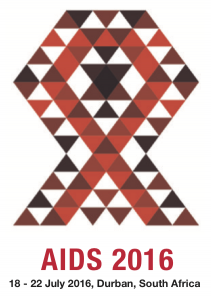Dolutegravir is superior to boosted atazanavir in women in the ARIA study
1 August 2016. Related: Conference reports, Antiretrovirals, Women's health, Pregnancy, World AIDS 21 Durban 2016.
 Polly Clayden, HIV i-Base
Polly Clayden, HIV i-Base
Dolutegravir-based ART was superior to a boosted atazanavir-based regimen in treatment naive women at 48 weeks, according to data from the ARIA study presented at AIDS2016.
The ARIA study was performed to provide additional data on women receiving the dolutegravir (DTG)-based fixed dose combination (FDC) in which it is co-formulated with abacavir (ABC) and lamivudine (3TC). [1] The FDC is marketed by ViiV Healthcare as Triumeq and was first approved in August 2014 in the US. [2]
The study is multi-national, multi-site, open label, randomised, non-inferiority, phase 3b. It is ongoing and enrollment was from September 2013 to September 2014
Catherine Orrell from the University of Cape Town presented 48-week data, on behalf of the ARIA investigators, in an oral late breaker. [3]
Eligible women were: ART-naive, HLA-B*5701 negative, with viral load 500 copies/mL or more and hepatitis B negative. They were randomised 1:1 to 48 weeks of treatment with DTG/ABC/3TC or atazanavir/ritonavir plus tenofovir DF/emtricitabine (ATV/r + TDF/FTC) once daily, and stratified by viral load less than or above 100, 000 copies/mL and CD4 count less than or above 350 cells/mm3.
Women who became pregnant during the course of the study were withdrawn and offered entry into a DTG/ABC/3TC pregnancy study. [4]
The primary endpoint was the proportion of women with viral load <50 copies/mL at week 48 using the FDA Snapshot algorithm (-12% non-inferiority margin).
A total of 495 women were randomised and treated: 248 and 247 in the DTG/ABC/3TC and ATV/r + TDF/FTC arms respectively. The women were a median age of 37 years; approximately 43% were of African origin, 45% were white and 22% were Asian. About half of the participants had CD4 <350 cells/mm3 and about 28% had viral load >100,000 copies/mL. Participants were well matched for demographic and baseline characteristics. Of the women in the DTG/ABC/3TC arm, 83% (n=206) completed week 48, compared with 78% (192) in the ATV/r + TDF/FTC arm.
Five women in the DTG/ABC/3TC arm (2%) and eight in the ATV/r + TDF/FTC arm (3%) became pregnant and withdrew from the study.
In ITT analysis, DTG/ABC/3TC was superior to ATV/r + FTC/TDF at 48 weeks: 82% vs 71% of participants had viral load <50 copies/mL respectively, adjusted difference 10.5% (95% CI: 3.1% to 17.8%), p=0.005.
Differences in response were driven by Snapshot virologic non-response (6% vs 14%) and fewer discontinuations due to adverse events or death (4% vs 7%) in the DTG/ABC/3TC arm.
No participant receiving DTG/ABC/3TC developed INSTI or ABC/3TC resistance. DTG/ABC/3TC had a favourable safety profile to ATV/r + TDF/FTC and a similar overall profile for DTG to that reported in previous studies.
Comment
The participants in the registrational studies (typically for such studies) were approximately 80% men (and few non-white participants), so this clinical trial evaluating DTG in women is welcome. More important still is data on pregnant women – which is essential to DTG’s recommendation in the WHO guidelines without restriction.
As noted above, five (2%) ARIA participants in the DTG/ABC/3TC FDC arm and eight (3%) in the ATV/r + TDF/FTC arm were discontinued from the randomised phase of the study due to pregnancy.
Of these pregnant women, four in each treatment group had undetectable viral load at the time of discontinuation. Two additional women became pregnant in the DTG/ABC/3TC FDC treatment group during the continuation phase of the study.
Of the seven women who became pregnant in the DTG/ABC/3TC arm (including during the continuation phase), three resulted in a normal infant with no apparent congenital anomaly, two women elected to terminate the pregnancy, one woman experienced an anembryonic pregnancy, and the outcome of one pregnancy was unknown. [5]
Other studies looking at DTG in pregnancy are described in Fit for Purpose 2016. [6]
References:
- US National Institutes of Health. A study to determine safety and efficacy of dolutegravir/abacavir/lamivudine (DTG/ABC/3TC) in Human Immunodeficiency Virus (HIV)-1 infected antiretroviral therapy (ART) naive women (ARIA).
https://clinicaltrials.gov/ct2/show/NCT01910402 - ViiV Healthcare (press release). ViiV Healthcare receives FDA approval for Triumeq. 22 August 2014.
https://www.viivhealthcare.com/media/press-releases/2014/august/viiv-healthcare-receives-fda-approval-for-triumeq.aspx - Orrell C et al. Superior efficacy of dolutegravir/abacavir/lamivudine (DTG/ABC/3TC) fixed dose combination (FDC) compared with ritonavir (RTV) boosted atazanavir (ATV) plus tenofovir disoproxil fumarate/emtricitabine (TDF/FTC) in treatment-naive women with HIV-1 infection (ARIA Study). AIDS2016. Oral abstract THAB0205LB.
http://programme.aids2016.org/Abstract/Abstract/10215 - US National Institutes of Health. ING200336, pharmacokinetic and safety study in pregnant women with human immuno virus infection.
https://clinicaltrials.gov/ct2/show/NCT02075593 - Questions to Dr Orrell following the presentation and personal communication from ViiV Healthcare.
- Clayden P. Fit for purpose: antiretroviral treatment optimisation. i-Base. 14 July 2016.
https://i-base.info/htb/30195

